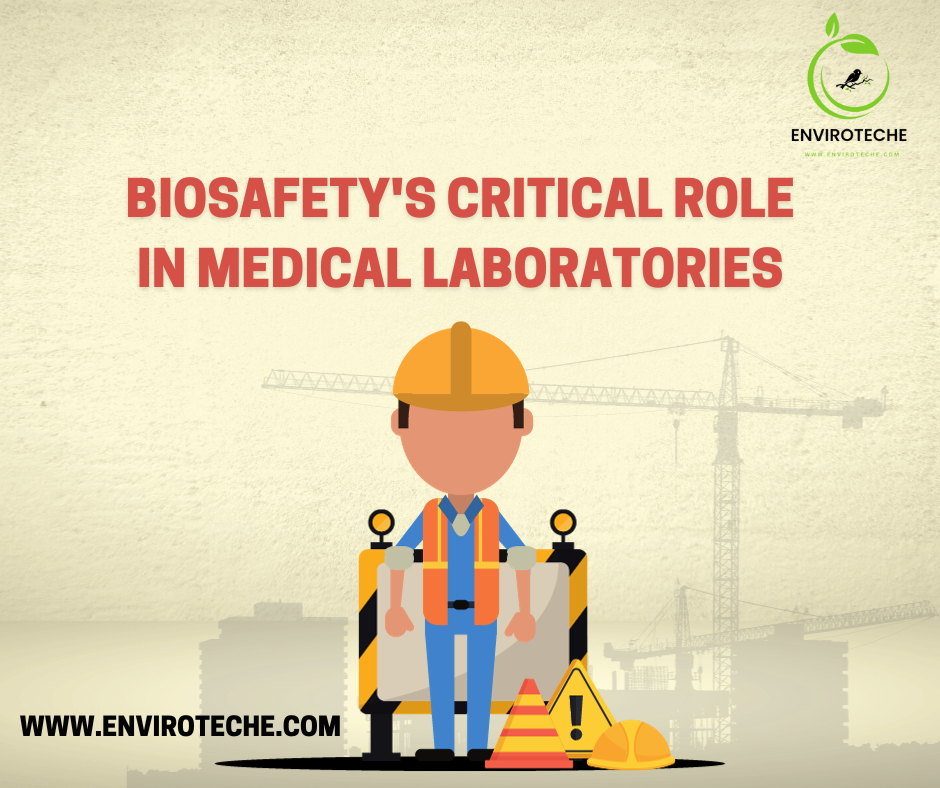Table of Contents

Importance of Biosafety
Biosafety plays an important role in our medical laboratory hospital for medical staff. We should be acknowledged of the personal health care, SOPs, and toxin substances that are harmful. If we follow the rules of biosafety, the chance of imprecise reports should be reduced, and also acknowledged about laboratory personnel hazardous chemicals. Therefore, we discuss below biosafety role in medical laboratories.
In this blog we will discuss; the Goal of biosafety, Personal health, BSL levels, SOPs of lab, Waste management, and Biosafety challenges of biosafety
Biohazards are those hazards that are caused by biological agents including bacteria. Viruses and pathogens. In order to prevent form this biological hazard we should follow proper prescribed standard operating procedures. The techniques for the prevention of biological hazards include proper immunization and the use of personal safety techniques (Djalante et al., 2020).
The goal of Biosafety
- Reduces of possible exposure.
- Ensure the safety of laboratory personnel from hazardous chemicals and equipment.
Medical laboratories are essential to the supply of healthcare because they offer patients and professionals critical diagnostic and testing services. While accuracy and timeliness are frequently the main concerns, biosafety is a crucial factor that should not be ignored. This blog explores the vital significance of biosafety in medical labs and the steps taken to ensure the protection of both patients as well as medical professionals (Stave & Wald, 2016).
Personal Health
The medical professor should be practicing personal hygiene and also wearing protective codling, protective inoculation, and medical examination in the lab.
Practice of personal hygiene
Lab Saffs must practice a high standard of personal hygiene, it includes the following;
- Washing hands and arms with soap before attending practices, and after handling specimen and infective material.
- Wearing closed shoes.
- No food or drink be stored in the lab refrigerator and also avoid drinking, smoking cosmetics, etc.
- Not placing pen, pencil, or other article near eyes, ears, and mouth.
Protective overalls
- Overalls should be normal clothes; fabric overalls are flammable resistance.
- Overalls or protective clothes always left in the lab and avoid drinking at home or another place of refreshment.
Gloves
- Gloves should be worn before taking specimen, culture containing high pathogens
- Used heat resistance gloves, when handling hot objects
- Chemical resistance should be worn when handling toxic pathogens
Safety Googles
- Safety Google should protect our eyes from chemical flashes, or other toxin
Protective Inoculation and Medical Examination
In the lab, there should be check be pre-staff health checks for all staff and vaccination for all staff from all pathogens under the supervision of a medical officer.
Protective inoculation against the Polio, TB, and so on.
Biosafety Level BSL
A system of containment methods and regulations known as Biosafety Levels (BSL) was developed to lab staff, the environment, and laboratory workers from exposure to potentially dangerous biological agents (Deka et al., 2020). Based on the amount of danger involved in handling the biological materials, these classifications are used to categorize laboratories and the work done there. BSLs offer a structure for creating suitable safety practices, laboratory layouts, and facility specifications. From BSL-1 (lowest danger) through BSL-4 (highest risk), there are four main BSLs
BSL-1 laboratories utilize well-characterized substances that aren’t routinely known to afflict healthy people with sickness. Handwashing is a common example of a standard microbiological practice that is adequate. Gloves and lab coats are examples of personal protection equipment (PPE) that must be worn. Laboratories with a BSL-2 classification deal with substances that are a moderate concern to the public and the laboratory staff.
Workers in laboratories undergo specialized training, and entry is controlled. Gloves, lab coats, and eye protection are all examples of PPE. Self-closing doors, regulated access, and the proper signs must all be present in laboratories. BSL-3 laboratories handle substances that, when breathed, can result in serious or even fatal illnesses. Controlled access, negative pressure airflow, and cleaning of all items leaving the lab are just a few of the stringent standards and containment measures in place (MWANSA, 2022). Specialized training and medical supervision are provided to staff members. Gloves, respirators, eye protection, and lab coats are all examples of PPE.
The most hazardous organisms are handled in BSL-4 facilities, sometimes without immunizations or therapies. It is necessary to use the maximum level of containment, which calls for intricate engineering controls and full-body suits with independent air supplies. There are strict admission and exit protocols, and access is restricted to highly qualified professionals only.Facilities with a BSL-4 rating are exceedingly uncommon and only used for the most dangerous agents, such smallpox and Ebola (MUSA, 2021).
Standard Operating Procedure
SOPs are essential records in many fields, including healthcare, labs, and research environments. These detailed instructions, which place an emphasis on consistency, safety, and quality, provide as a road map for carrying out particular activities and procedures. SOPs are essential for ensuring that operations follow accepted standards, legal obligations, and industry best practices. They aid in the training of workers by offering detailed instructions, empowering them to carry out their responsibilities with accuracy and confidence.
SOPs are furthermore crucial for risk reduction, preparedness for emergencies, and documentation, assisting institutions in properly handling unanticipated scenarios and keeping detailed records of their operations. SOPs are essential instruments for preserving people’s well-being due to the continual evaluation and modification that ensures their relevance and conformity with changing practices and rules (Alhassan, 2020).
Biological Waste Management
For the safety of technicians, patients, and the general public, biological waste management in medical laboratories is of utmost significance. These specialized facilities produce a wide range of potentially infectious biohazardous items, including blood samples, tissues, cultures, and sharps. To avoid unintentional exposures, laboratory-acquired illnesses, and the transmission of diseases, proper disposal of these items is crucial (Alhassan, 2020).
The waste that is produced in medical labs is often divided into many kinds, each of which has a particular method for disposal. To sustain legal requirements and safeguard the integrity of healthcare services and research, thorough regulatory compliance and documentation of waste management processes are crucial.
It is equally important that lab staff members are well-versed in proper waste management and disposal techniques. Good emergency response and event reporting depend on good communication and training. The emergency response skills of laboratory workers should be well-honed, and they should know where to find safety equipment and emergency exits. In addition, well-defined communication protocols guarantee that all staff members are aware of who to call and how to share information during an event (Kong et al., 2019).
Biosafety challenges and innovation in pandemic response
The rise of pandemics, like the COVID-19 pandemic, has created specific biosafety difficulties that call for creative solutions and a revaluation of current standards. One of the main issues has been the urgent need to scale up diagnostic testing and research activities, which frequently necessitates the creation of temporary laboratories or the conversion of existing facilities for high-containment operations.
This called for the creation of adaptable, modular biosafety systems that could be used right away. Expanding testing capacities, particularly in rural or underserved locations, has been made possible by mobile labs and diagnostic testing units with integrated biosafety safeguards (Kong et al., 2019). Transporting and handling potentially contagious samples safely has proven to be difficult. The danger of unintentional exposures occurring during sample transfer has been significantly reduced because to advancements in sample packing and transportation techniques, including strong sample confinement, temperature control, and real-time tracking.
Global supplier of personal protective equipment (PPE) has been constrained by the rise in demand during pandemics. Innovations in PPE manufacture, distribution, and design have been crucial. To solve shortages, reusable PPE with improved durability and cleaning procedures have been investigated (Parminder et al., 2019).
Conclusion
In conclusion, biosafety in medical laboratories is crucial for safeguarding the security of lab workers, the Caliber of healthcare services, and the safety of the general public. These procedures serve as the cornerstone of a secure, accountable, and effective laboratory setting, from the cautious handling of biohazardous items through the thorough disposal of trash. The importance of biosafety in preventing lab-acquired illnesses, guaranteeing research integrity, and adhering to laws highlights the necessity of this function.
Prioritizing safety and fostering a climate of vigilance and ongoing improvement within the laboratory community are tasks that we must all share. Whether you work as a researcher, physician, lab worker, or any other type of stakeholder, your dedication to adhering to best practices and keeping current with changing biosafety regulations is crucial.
References
Alhassan, A. R. (2020). INFECTIONS PREVENTION AND CONTROL PRACTICES AMONG HEALTHCARE PROVIDERS AT THE SURGICAL DEPARTMENT OF TAMALE TEACHING HOSPITAL.
Deka, R. P., Sharma, P. K., Lindahl, J. F., & Grace, D. (2020). Biosafety manual for milk and meat testing laboratory.
Djalante, R., Shaw, R., & DeWit, A. (2020). Building resilience against biological hazards and pandemics: COVID-19 and its implications for the Sendai Framework. Progress in Disaster Science, 6, 100080.
Kong, I., Law, M. C., & Ng, G. S. (2019). Clinical practice guidelines for the provision of renal service in Hong Kong: Renal Nursing Practice. Nephrology, 24, 77–97.
MUSA, M. R. S. M. I. (2021). A TECHNICAL REPORT ON STUDENT INDUSTRIAL WORK EXPERIENCE SCHEME (SIWES). DEPARTMENT OF MICROBIOLOGY, BAYERO UNIVERSITY, KANO.
MWANSA, H. (2022). MEASURES UTILIZED FOR PREVENTION OF NOSOCOMIAL INFECTION IN LABOUR WARD: AT UNIVERSITY TEACHING HOSPITAL (UTH) IN ZAMBIA. Cavendish University.
Parminder, K., Kaur, M. H., & Bhupinder, K. (2019). A study to assess the effectiveness of child to child approach on knowledge and practices regarding hand washing among the primary school children of a selected school Faridkot, Punjab. Amarjeet Kaur Sandhu, 11(4), 461.
Stave, G. M., & Wald, P. H. (2016). Physical and biological hazards of the workplace. John Wiley & Sons.
Author Details
Muhammad Azam 1, Wazir Muhammad Ikhlaq2
1Department of Allied Health Professionals (MLT), Government College University Faisalabad1,
2Department of Chemistry Government College University Faisalabad2
Check Other Scholarships:
